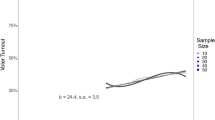Abstract
A previous paper showed that a simple prospective model of voting and party identification subsumed much of the social-psychological and retrospective voting literatures, in the sense that it rigorously implied their key findings and added many new ones as well. This paper extends the argument by showing that the same prospective voting model has drastic implications for conventional statistical specifications in voting research. First, linear models should be discarded in favor of a particular nonlinear specification. Second, demographics should be dropped from the list of independent variables.
Similar content being viewed by others
Author information
Authors and Affiliations
Rights and permissions
About this article
Cite this article
Achen, C.H. Social psychology, demographic variables, and linear regression: Breaking the iron triangle in voting research. Polit Behav 14, 195–211 (1992). https://doi.org/10.1007/BF00991978
Issue Date:
DOI: https://doi.org/10.1007/BF00991978




